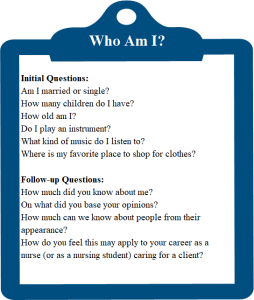4 Teaching Strategies, Vickie Green, MSN, RN

Teaching Strategies
Nurse Educators should recognize the importance of creating and implementing teaching methodologies which promote diversity in the classroom. Some research reveals that colleges and organizations may articulate messages of diversity, but fail to fully incorporate them into practice (Jamison, 2021). Diversity is essential in the classroom because it can improve students’ self-efficacy, which further promotes student success in academics (Kahlenberg, et al., 2019).
According to Haroun & Royce (2004), when students learn about diversity, it helps them grow into becoming individuals who are more open-minded about cultural differences and better able to identify their own biases. Diversity education may also provide an avenue for students to build on critical thinking by reflecting on past experience and bias. When students interact with others who are different, it forces them to ask questions and to better develop social awareness about their society (Kampen, 2020). By implementing this, it opens an avenue for Nurse Educators to promote DEI through various teaching strategies.
One change that could be implemented is to include images of people that represent different ethnicities, shapes, sizes, abilities and clothing styles into classroom activities to promote diversity. Another important way to incorporate diversity into the classroom is by inviting diverse speakers. This strategy enables students to interact with diverse populations and engage in meaningful discussions (The Power of Play, 2015).
Sharing our personal experiences can bring about meaningful change and personal growth. Experiences promote inclusiveness and are great ways to address barriers. Sometimes, when we are not comfortable discussing differences, we avoid them. Nurse Educators should address and promote conversation about DEI in the classroom.
In considering innovative strategies that promote diversity, consider some activities that have been used at the University of North Alabama, in nursing classes taught at the Anderson College of Nursing & Health Professions (ACONHP). These activities are meant to engage students in active diversity and help them understand that the population they serve is diverse. Each activity will include an explanation on how it works. Sometimes, we are uncomfortable with how to approach diversity, but these activities can increase comfortability and ease when it comes to conversation, recognition of diversity, and the value of inclusion.
On the first day of classes, it is always a good idea to integrate an icebreaker, to help students feel more comfortable and safe. It is also a way for them to meet their peers and see that they all bring something unique to the table. One of the ice breakers used in previous ACONHP classes is a game called, “Who Am I?” adapted from a book of teaching ideas for classroom activities (Haroun & Royce, 2004). The activity has a handout with questions about the instructor (that the instructor is willing to answer at the end of class). The instructor will ask the student to answer the questions to the best of their ability, with guessing allowed.
The objective of the activity is to discuss how individuals are often judged on the basis of how they look or what they do. It is a good segue into discussing biases and how they negatively impact nursing services. At the end of the exercise, the instructor must be willing to give the students the correct answer and then follow up with another discussion. Of course, Nurse Educators can change the questions as needed (see Figure for example questions that could be included in the activity).
Another strategy that promotes DEI is role play, which allows students to place themselves in another’s shoes. Role play assists the instructor in facilitating open dialogue and allow for student reflection on sensitive topics. Essentially, this strategy is an opportunity to provoke various topic discussions, while also decreasing any anxiety related to cultural differences.
Typically, the history of nursing is one of the initial topics students learn about. One prominent figure that is always discussed in the foundation of nursing is Florence Nightingale. Her work as a nurse is often honored, but in fulfilling DEI goals, others can be integrated as well – such as Mary Eliza Mahoney. As the first African-American to study and professionally work as a nurse in the United States, she championed increased access to nursing education and fought against discrimination in the profession throughout her career. By incorporating diverse founders and pioneers of the profession, Nurse Educators are acknowledging and celebrating the transformation of nursing diversity and inclusion. Even throughout healthcare, diverse contributions exist. Henrietta Lacks and her HeLa cells have been the cornerstone of many research studies. Mention of Ms. Lacks can invoke discussion of her treatment, which also highlights inequities in healthcare; this can also be balanced with discussion on how her cells have provided immeasurable benefits to medical research.


